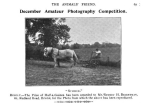This is from The Animals’ Friend (London, 1896-7 issue), a journal devoted to the humane protection of animals—apparently, they drew their line at “depredat[ing]” mice.
Month: October 2012
This photo makes me smile.
To My Dog Rex
By Mrs. S.W. Jewett
[published in Our Animal Friends v. 20 (Sept. 1894)]
FRIEND, if the gift of human speech denied
Thy noble race were granted thee to-day,
And thou couldst thus thy inmost thought unfold,
What wouldst thou say?
If the beseeching pathos of those eyes,
Fixed on my own with sad but mute appeal,
Could voice itself in words, what more of love
Could they reveal?
I ask no other token of thy truth,
Thy deep affection, steadfast loyalty,
Than those far-reaching and imploring eyes
Unfold to me.
Could human hearts thus meet in full accord,
And each to each their fervent love express,
How many a life were blessed, now languishing
In loneliness!
This little poem, written expressly for Our Animal Friends, the ASPCA’s publication, captures a beautiful sentiment we’re very familiar with: dogs can make you feel loved just by the way they look at you. But notice how she begins by asking (with apparent sincerity, addressing her dog as “FRIEND”) what he would say if he could speak? At the opening verse, she assumes he has (at least one!) “inmost thought” to “unfold” with the gift of speech. By the second verse, however, this “inmost thought” becomes more limited: she begins to assume that what he would say would merely be “more of love.” By the flip of the third verse, Jewett is no longer concerned about whether Rex can or cannot speak, having determined that he would merely say love-related things. The dogs’ eyes “unfold” enough on this topic. The question of speech, to a dog, becomes irrelevant.
The Paradoxical Cat
In the nineteenth century, it was common to refer to any cat generically as “pussy” or “tabby.” In this 1869-70 article we can see the great interest that Americans were developing towards compiling knowledge about the animals they were adopting as family members in droves (“Pussy,” reprinted in the compendium, Harper’s New Monthly Magazine vol. XL). Cataloguing a history of cat worship beginning with the Egyptians, this writer traces historical and global attitudes then turns to a rather harsh critique of the feline character. Both defending the cat from the historical “savage cruelty” that has been the hallmark of the Occident’s treatment of the cat, then undercutting his/her own defense by demonizing the cat (“[f]or cunning and treachery are the leading features in the character of cats”), the writer illustrates the conflicted way in which cats were viewed during this period. Alongside a valorization—Kathleen Kete has called this a “rehabilitation”—of the cat remained a strong aversion to its alleged character flaws (selfish, unfeeling, disloyal, supernatural). It was a general question, really: what do we do with the cat? Is it good? Is it bad? Can we trust it?
The article is accompanied with various (multicultural!) images of cats that for the most part portray the cat in a desirable light—yet another jarring contrast to the charges the writer levies against this animal.





At this moment in our cultural history, the cat occupied a unique paradoxical position, a position which I hypothesize likely served certain interests in the cultural wars. In the third chapter of my book, I am exploring the how and why of these paradoxical discourses about the cat, which were so frequently juxtaposed, as a matter of general practice, against discourses of the loyal and faithful dog.
Selfish Brutes
Many have expressed reasons to envy animals; my cats, for one, seem to sleep while I work all day.
“The life of the brute has commonly one immense compensation in its favour,” that is, “the perfection of the individual existence is so rarely sacrificed to the prosperity of the race.” In his Chapters on Animals, Philip G. Hamerton (Boston, 1877) seems to focus on the notion that one animal’s benefit need not hinge on another’s “enduring misery”: “There is much slaughter…but…little slavery,” and the killing is practically a mercy that spares the animal’s descent into sad “infirmity and age.”
It doesn’t take a lot of Discovery Channel to know that Hamerton was wrong in so many ways, but I’m particularly interested in his premise that animals are somehow deeply independent, outside of the cycles of nature, alienated even from members of their own species. In this, he suggests a more profound reason for envying the animal: their alleged selfishness. The uber-individualist animal that Hamerton proposes might not exist, but the fact that he envies this figment of his imagination is pretty telling.
Animals as effigies
When we regard a certain animal as an embodiment of some value (lion for courage, donkey for pessimism, bull for stubborn), we participate in the creation of an effigy. The animal becomes a something that we can castigate in place of, or alongside, the “real thing.”
Cats, for example, have been cast infamously in the role of witches’ familiars—as embodiments of supernatural evil—for which they have been condemned alongside their mistresses. “Women were frequently drowned…especially adulteresses and witches,” records C.V. Roman, a doctor in Philadelphia writing in 1916 about the 16th century, “being generally put in a bag along with a cat or a snake, and cast into a pond.” In Chambers’s Encyclopedia of 1870, it is recorded that in Saxony, “a woman convicted of child-murder, was sewn up in a sack, along with a cat, a dog, and a snake, and thus drowned, in 1734.” This is probably an illustration of the kind of practice that The Atheneum (in 1829) described as drowning “unfortunate persons…in a sack with obscene animals.”
What makes an animal obscene? Or, rather, why do we make certain animals obscene?


